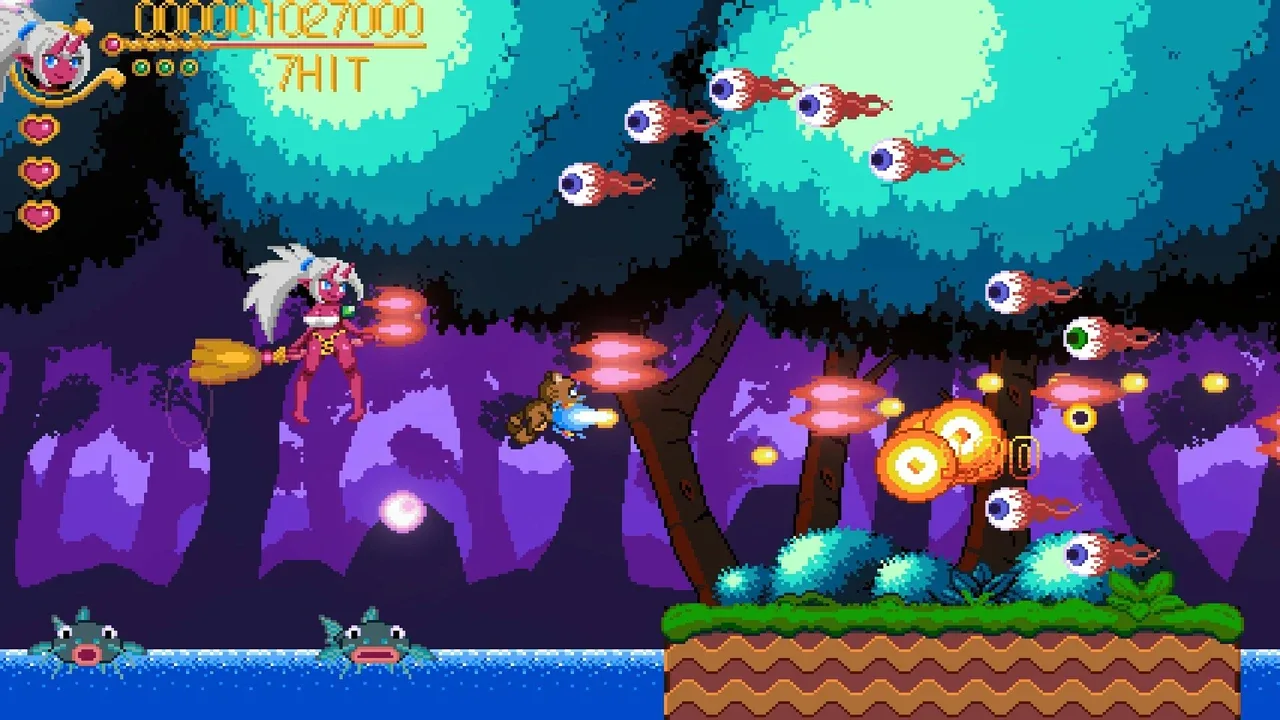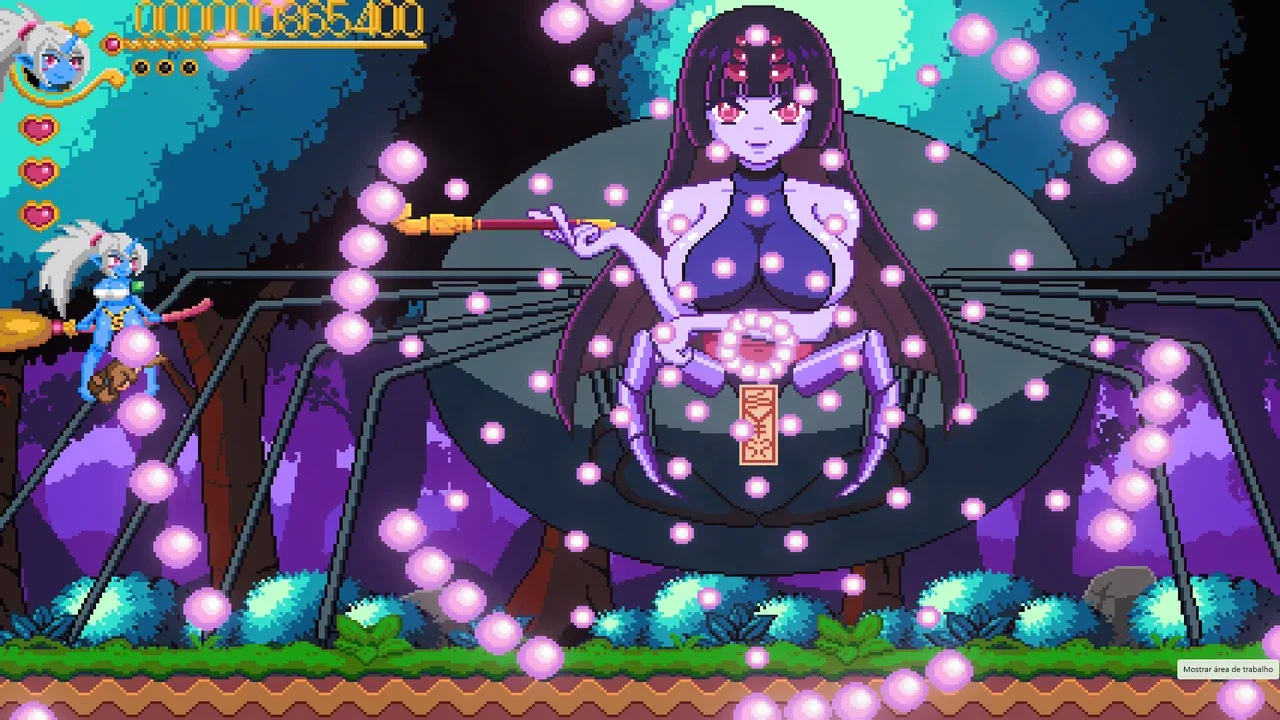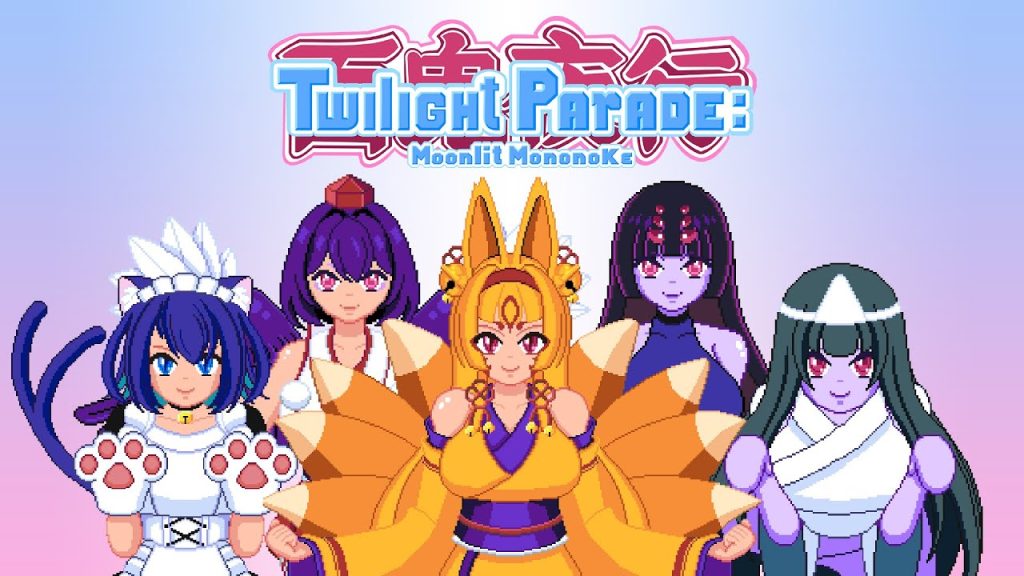As the fourth release (and third shoot-’em-up) from solo developer Super16Bits, Twilight Parade: Moonlit Mononoke comes with a bit of experience behind it. When it comes to the game’s visual design, that certainly shows: a colourful pixel-art aesthetic and yokai-themed character and enemy designs call to mind the genre’s classics, while dense, visually-striking bullet patterns hint at the organised chaos that makes bullet hell shooters so entrancing. Sadly, that experience doesn’t really carry through to the substance of the game. Impressive visuals and a solid shooting foundation aside, Twilight Parade feels unremarkable and, at worst, incomplete.
Let’s start with what the game does well. Like I said, it looks fantastic: colours pop on the screen, while the pixel art style channels retro inspirations beautifully. The comically suggestive, big-breasted character designs won’t appeal to everyone, but they’re playful and full of life, while enemies capture the essence of a handful of common yokai (ghosts and monsters from Japanese folklore) in a cartoonish style. There are four characters to choose from, each with a traditional outfit and a swimsuit variant—again, comically suggestive is very much the goal here—and five colourful, detailed bosses that breast boobily while the unleash intricate shot mazes for players to navigate.

The basics of the shooting mechanics work well. Each character has a slightly different shot pattern and a drone or two that provides extra fire—they’re all some form of a linear forward shot, so they’re not quite different enough to make the characters feel entirely unique, but they get the job done. A slow movement button helps with navigate the narrow spaces between bullets, as does the tiny hitbox that’s clearly signalled with a gem in each character’s necklace. A limited supply of bombs give players a way to clear the screen and get out of trouble if needed. Dodge bullets, shoot enemies, bomb if you must—that’s the basic structure of any shoot-’em-up, and Twilight Parade gets it done.
Unfortunately, some strange design decisions and a complete lack of anything beyond the bare essentials make the game feel underbaked and unexciting. As I said before, the characters are all quite similar in how they play in that they all have some form of a linear forward shot; they’re also generally quite weak, and there’s absolutely no power up system of any sort. The combination of low power and lack of any sort of spread shot makes dealing with swarms weak enemies feel tedious, while bigger foes and bosses become annoying bullet sponges.
When it comes to said bosses, their bullet hell attack patterns initially look impressive: they’re elaborately designed, and absolutely flood the screen with shots that can only be avoided with careful micro-dodging. That’s fine, and a common feature of shoot-’em-ups … but in Twilight Parade, that’s all there is. Every attack from every boss is solved by basic tap-dodging, which is just one small part of what makes a good bullet hell tick. There are no attacks that force you to move in strategic ways, manage your position on screen, or test your ability to read complex patterns; it’s all just webs of slow-moving bullets to micrododge between.

The lack of pattern design nuance becomes even more apparent when you realise how many attacks have safe spots, and how easy they are to organically find. When every attack is about reacting to immediate threats with small movements, it very quickly becomes apparent when you’re no longer in the path of any bullets for a given attack—a situation that comes up surprisingly often.
The attacks that don’t have safe spots are usually the rare few that have overlapping shots coming from different angles and different speeds, but here you suddenly run into a different problem: all enemy shots are the same size, shape, and colour. There’s a good reason most bullet hells have some form of visual distinction between bullets, be it DoDonPachi’s dual colours or the various shapes of Mushihimesama’s bright purple shots: this helps make these oppressive attacks legible. Without that, Twilight Parade’s more complex patterns just get messy—more difficult, sure, but not in a way that’s enjoyable.
This issue is compounded by some very dodgy hit detection. Although the hitbox in Twilight Parade is visually very small, it feels a lot bigger than it looks—I lost count of the number of times I died while being absolutely certain I dodged safely. I suspect it’s a case of both the hitbox and enemy shots having collision boxes that match the sprite exactly, without any leeway, which can result in collisions being detected by the game before they’re rendered on screen and create the experience of dying to a shot you didn’t actually see making contact. There’s a reason most bullet hells have collision boxes that are smaller than what you actually see on screen.

In one of the most bizarre design decisions I think I’ve ever seen in a shmup, there’s a slot machine between levels, at which you can have to spend any coins you collected so far. Depending on how many coins you’ve gathered, you could be forced to play this slow, time-wasting slot machine a dozen times, absolutely halting any momentum in a genre built around exactly that. Successfully matching three faces—which is very easy to do, given how slow the wheels turn—earns you an extra life, making it trivial to collect so many extra lives that they disappear off the screen. I can appreciate the idea of wanting a little mechanical interlude between levels, but this one just fundamentally does not work.
Lastly, Twilight Parade falls short in its complete lack of even the most standard shoot-’em-up system features. Despite having a simple scoring system, there’s no leaderboard whatsoever—not even a local one. You can’t even really see your final score, because as soon as you defeat the last boss, the game just suddenly ends and returns to the main menu—no epilogue, no results screen, no nothing. There’s no button config, so you’re stuck with a slightly unwieldy default configuration. There’s certainly no practice mode or any settings to modify difficult level or default starting lives.

All these things make Twilight Parade: Moonlit Mononoke feel more like a proof of concept than a commercial release. Its vibrant art style looks great and calls to mind arcade classics, but missing core shoot-’em-up features, the bizarre slot machine thing, lack of variety, and bland boss attack patterns all add up to forgettable game that, at worst, feels incomplete.
Colourful pixel art aside, too many missing core features and questionable design decisions make this feel more like a proof of concept than a commercial release.

